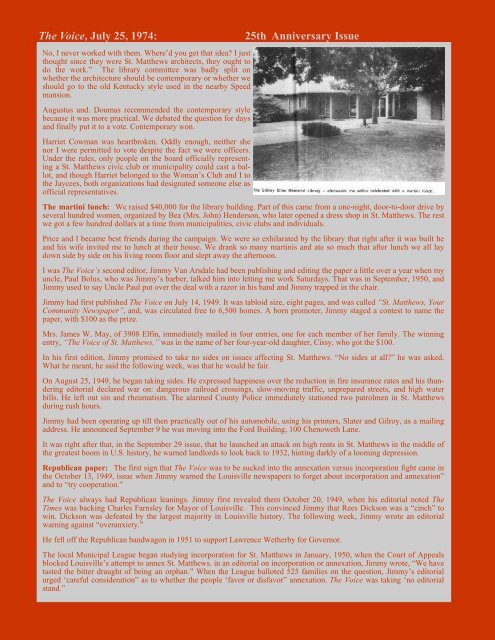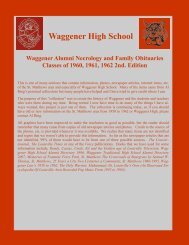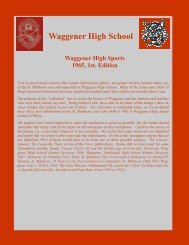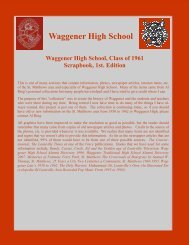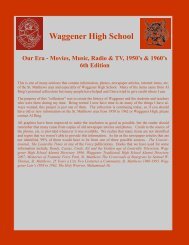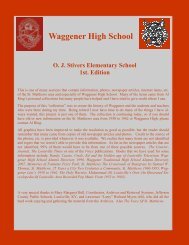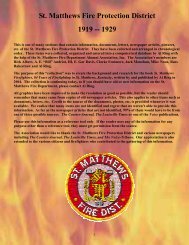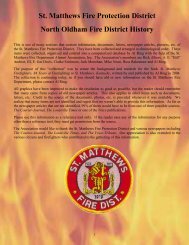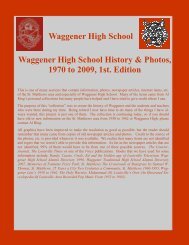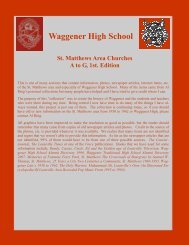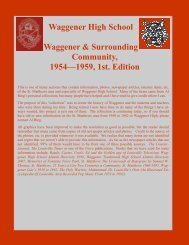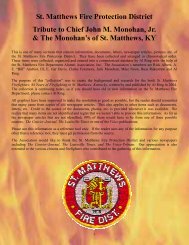The Voice, July 25, 1974:Reading it now 20 years later, I am astounded at how much I wrote and how fact-filled the history is. Its inordinate lengthrequired us to publish it two weeks running.Frankly, I think I wrote more than anyone wanted to know about St. Matthews, dating clear back to pioneer days. I hadstudied county records, doctors’ theses and old newspapers — and had interviewed old-timers like Tony Eline. And I put itall in. But long and rambling as it is, I am proud of one thing. Not a single fact in those thousands of words was ever challengedfor accuracy.I served as news editor and then editor of The Voice from the fall of 1950 till the fall of 1960, except for an eight-monthperiod in 1952 when I lived in Europe.During those years of the ‘50s -- golden for the nation and for me personally in fond retrospect-- St. Matthews grew up.Most of the shopping centers including the Shelbyville Road Plaza and The Mall were built, as were most of the schoolsincluding <strong>Waggener</strong>, Stivers and St. Matthews Elementary. Most of the sixth-class cities were formed. As editor I applaudedand promoted this development.My old publisher, Al Schansberg, took a leading role in publicizing and promoting Little League, Pony League and theBabe Ruth League, all of which were formed during the 1950s.Dick Clay, an old college chum, and I organized the old St. Matthews Community Theatre which during the ‘5Os stagedsuch classics as “You Can’t Take It With You,” “Ten Little Indians” and ‘Hedda Gabler.” We were aided by many amateurenthusiasts including Wanda Receveur, Gladys Griffin, Rowena Freeman, Lin and Reeda Bivins, Tappy and Van Fell andmany, many others.But the achievement of which I am proudest was building the Eline Memorial Library in St. Matthews near Harvey BrowneChurch.This rewarding adventure began on a quiet day in The Voice office in late 1957 or early 1958. I was alone, it was a Thursday,the paper was out, there was nothing much to do and I was smoking a cigarette and staring out the window when alittle old lady walked in and introduced herself as Harriet Cowman.We liked each other immediately and I nodded sympathetically when she said she was surprised that a thriving <strong>com</strong>munitylike St. Matthews had such an inadequate library. The existing facility was a rented one-room affair on St. Matthews Avenuejust north of Shelbyville Road, open only 12 hours a week (if memory serves) and operated by the Louisville PublicLibrary.“If I get a drive started to build a new library, will you give us publicity?’ she said.“Yes, rna’am, you can count on it.”She turned to leave and then changed her mind. She looked me right in the eye. “(think you’re the man to build the library,”she said.I refused. I had just been divorced, was feeling very sorry for myself, and had no stomach for any crusades, not even one asworthy as a library.But she was a woman who could not accept ‘no.” She kept after me until I reluctantly agreed. Shortly afterward, we calledour first meeting in The Voice office, inviting all the civic clubs and municipalities to send representatives.It was snowing on the appointed night and only eight people showed up, including myself and Harriet Cowman. We werediscouraged but did not give up. Oddly enough, exactly one year from that date the library was <strong>com</strong>pleted and dedicated.I was elected first chairman of the Library Committee, druggist Price Webb (now dead, alas) of the Lions Club was vicechairman, and Harriet was chief cheerleader. We asked the civic clubs and municipalities to each appoint an official representativeto the board. Many of them did.Tony grumbled: A. J. . Tony Eline donated the land. He was one of the most successful entrepreneurs in St. Matthews’history, having made a fortune in real estate development and auto sales. He gave us the two lots on which the library nowstands and added $10,000 to the gift. In return we agreed to name the library after his son, Sidney, who was killed in WorldWar II.Tony was an argumentative man. He suggested we get Augustus and Doumas, architects, to design the building and superviseits construction. Then he grumbled after we did because Ed Augustus and John Doumas — who generously did all thework for nothing — hired union labor to carry out construction. “I could have got it done a lot cheaper,” he <strong>com</strong>plained.“But, Mr. Eline,” I protested. “You re<strong>com</strong>mended them to us.”“Well, I didn’t know they'd use union labor.”25th Anniversary Issue“But I thought you had worked with them before. Why did you re<strong>com</strong>mend them?
The Voice, July 25, 1974:No, I never worked with them. Where’d you get that idea? I justthought since they were St. Matthews architects, they ought todo the work.” The library <strong>com</strong>mittee was badly split onwhether the architecture should be contemporary or whether weshould go to the old Kentucky style used in the nearby Speedmansion.Augustus and. Doumas re<strong>com</strong>mended the contemporary stylebecause it was more practical. We debated the question for daysand finally put it to a vote. Contemporary won.Harriet Cowman was heartbroken. Oddly enough, neither shenor I were permitted to vote despite the fact we were officers.Under the rules, only people on the board officially representinga St. Matthews civic club or municipality could cast a ballot,and though Harriet belonged to the Woman’s Club and I tothe Jaycees, both organizations had designated someone else asofficial representatives.25th Anniversary IssueThe martini lunch: We raised $40,000 for the library building. Part of this came from a one-night, door-to-door drive byseveral hundred women, organized by Bea (Mrs. John) Henderson, who later opened a dress shop in St. Matthews. The restwe got a few hundred dollars at a time from municipalities, civic clubs and individuals.Price and I became best friends during the campaign. We were so exhilarated by the library that right after it was built heand his wife invited me to lunch at their house. We drank so many martinis and ate so much that after lunch we all laydown side by side on his living room floor and slept away the afternoon.I was The Voice’s second editor, Jimmy Van Arsdale had been publishing and editing the paper a little over a year when myuncle, Paul Bolus, who was Jimmy’s barber, talked him into letting me work Saturdays. That was in September, 1950, andJimmy used to say Uncle Paul put over the deal with a razor in his hand and Jimmy trapped in the chair.Jimmy had first published The Voice on July 14, 1949. It was tabloid size, eight pages, and was called “St. Matthews, YourCommunity Newspaper”, and, was circulated free to 6,500 homes. A born promoter, Jimmy staged a contest to name thepaper, with $100 as the prize.Mrs. James W. May, of 3908 Elfin, immediately mailed in four entries, one for each member of her family. The winningentry, “The Voice of St. Matthews,” was in the name of her four-year-old daughter, Cissy, who got the $100.In his first edition, Jimmy promised to take no sides on issues affecting St. Matthews. “No sides at all?” he was asked.What he meant, he said the following week, was that he would be fair.On August 25, 1949, he began taking sides. He expressed happiness over the reduction in fire insurance rates and his thunderingeditorial declared war on: dangerous railroad crossings, slow-moving traffic, unprepared streets, and high waterbills. He left out sin and rheumatism. The alarmed County Police immediately stationed two patrolmen in St. Matthewsduring rush hours.Jimmy had been operating up till then practically out of his automobile, using his printers, Slater and Gilroy, as a mailingaddress. He announced September 9 he was moving into the Ford Building, 100 Chenoweth Lane.It was right after that, in the September 29 issue, that he launched an attack on high rents in St. Matthews in the middle ofthe greatest boom in U.S. history, he warned landlords to look back to 1932, hinting darkly of a looming depression.Republican paper: The first sign that The Voice was to be sucked into the annexation versus incorporation fight came inthe October 13, 1949, issue when Jimmy warned the Louisville newspapers to forget about incorporation and annexation”and to “try cooperation.”The Voice always had Republican leanings. Jimmy first revealed them October 20, 1949, when his editorial noted TheTimes was backing Charles Farnsley for Mayor of Louisville. This convinced Jimmy that Rees Dickson was a “cinch” towin. Dickson was defeated by the largest majority in Louisville history. The following week, Jimmy wrote an editorialwarning against “overanxiety.”He fell off the Republican bandwagon in 1951 to support Lawrence Wetherby for Governor.The local Municipal League began studying incorporation for St. Matthews in January, 1950, when the Court of Appealsblocked Louisville’s attempt to annex St. Matthews. in an editorial on incorporation or annexation, Jimmy wrote, “We havetasted the bitter draught of being an orphan.” When the League balloted 525 families on the question, Jimmy’s editorialurged ‘careful consideration” as to whether the people ‘favor or disfavor” annexation. The Voice was taking ‘no editorialstand.”
- Page 2 and 3:
Explanation of the following pages,
- Page 4 and 5:
The Voice of St. Matthews, April 20
- Page 6 and 7:
The Voice of St. Matthews, April 20
- Page 8 and 9:
The Voice of St. Matthews: July 17
- Page 10 and 11:
The Voice of St. Matthews: Septembe
- Page 12 and 13:
The Voice of St. Matthews, Septembe
- Page 14 and 15:
The Voice of St. Matthews, Septembe
- Page 16 and 17:
The Voice of St. Matthews, January
- Page 18 and 19:
The Voice of St. Matthews, January
- Page 20 and 21:
The Voice of St. Matthews:1955 Adve
- Page 22 and 23:
The Voice of St. Matthews, May 5, 1
- Page 24 and 25:
The Voice of St. Matthews, January
- Page 26 and 27:
The Voice of St. Matthews, January
- Page 28 and 29:
The Voice of St. Matthews, January
- Page 30 and 31:
The Voice of St. Matthews, January
- Page 32 and 33:
The Voice of St. Matthews, January
- Page 34 and 35:
The Courier-Journal, October 20, 19
- Page 36 and 37:
The Courier-Journal, October 20, 19
- Page 38 and 39:
The Voice Of St. Matthews, January
- Page 40 and 41:
The Voice Of St. Matthews, January
- Page 42 and 43:
The Voice Of St. Matthews, January
- Page 44 and 45:
The Voice Of St. Matthews, January
- Page 46 and 47:
The Voice Of St. Matthews, January
- Page 48 and 49: The Voice Of St. Matthews, January
- Page 50 and 51: The Voice Of St. Matthews, February
- Page 52 and 53: The Voice Of St. Matthews, July 18,
- Page 54 and 55: The Voice of St. Matthews, August 1
- Page 56 and 57: The Voice of St. Matthews, August 1
- Page 58 and 59: The Voice of St. Matthews, January
- Page 60 and 61: The Voice of St. Matthews, January
- Page 62 and 63: The Voice of St. Matthews, January
- Page 64 and 65: The Voice of St. Matthews, January
- Page 66 and 67: The Voice of St. Matthews, January
- Page 68 and 69: The Voice of St. Matthews, January
- Page 70 and 71: The Voice of St. Matthews, January
- Page 72 and 73: The Voice of St. Matthews, April 2,
- Page 74 and 75: The Voice of St. Matthews, July 16,
- Page 76 and 77: The Voice of St. Matthews, July 16,
- Page 78 and 79: The Voice of St. Matthews, July 16,
- Page 80 and 81: The Voice of St. Matthews, July 16,
- Page 82 and 83: The Voice of St. Matthews, July 16,
- Page 84 and 85: The Voice of St. Matthews, July 16,
- Page 86 and 87: The Voice of St. Matthews, July 16,
- Page 88 and 89: The Voice-Jeffersonian, April 9, 19
- Page 90 and 91: The Voice-Jeffersonian, April 9, 19
- Page 92 and 93: The Voice-Jeffersonian, April 9, 19
- Page 94 and 95: The Voice-Jeffersonian, April 9, 19
- Page 96 and 97: Jim Herron Collection:L & N St. Mat
- Page 100 and 101: The Voice, July 25, 1974:25th Anniv
- Page 102 and 103: The Voice, July 25, 1974:falling li
- Page 104 and 105: The Voice, July 25, 1974:Under Ogle
- Page 106: The Voice, July 25, 1974:25th Anniv


